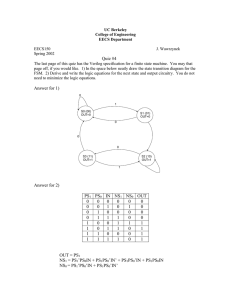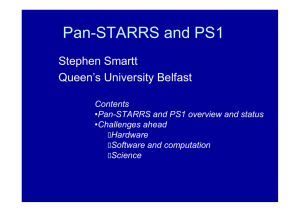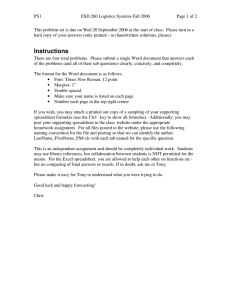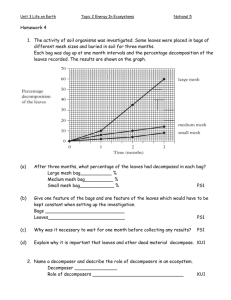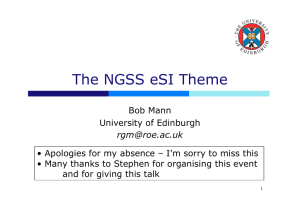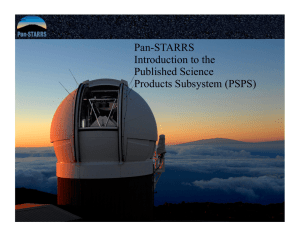Document 15482860
advertisement
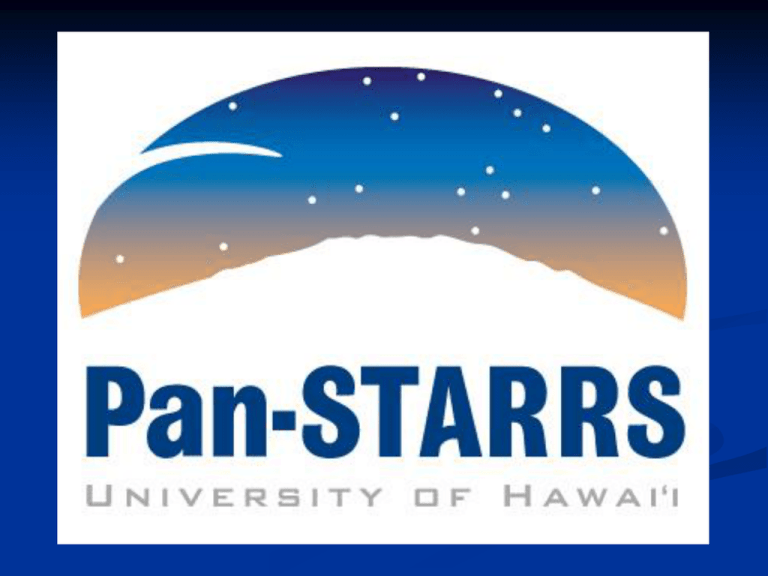
The Key Players Maria Nieto-Santisteban (JHU) Ani Thakar (JHU) Alex Szalay (JHU) Jim Gray (Microsoft) Catherine van Ingen (Microsoft) What is Pan-STARRS? Pan-STARRS - a new telescope facility 4 smallish (1.8m) telescopes, but with extremely wide field of view Can scan the sky rapidly and repeatedly, and can detect very faint objects Unique time-resolution capability Project was started by IfA with help from Air Force, Maui High Performance Computer Center, MIT’s Lincoln Lab and Science Applications International Corp. SAIC has dropped out & the JHU database team has joined. The PS-4 Telescope Array Concept The PS1 Prototype – Walk before you run! Pan-STARRS pushes 4 areas of technology: wide-field imaging telescope, large format CCD mosaic camera, high throughput image processing pipeline, & data-intensive database server. We were advised to build a functional prototype, PS1, to test and integrate these new approaches. The prototype, PS1, is now nearing operational readiness on Haleakala, Maui. The PS1 Science Consortium University of Hawaii, Institute for Astronomy Max Plank Society, Institutes in Garching & Heidelberg Harvard-Smithsonian Center for Astrophysics Las Cumbres Observatory Global Telescope Network Johns Hopkins University, Department of Physics and Astronomy University of Edinburgh, Institute of Astronomy Durham University, Extragalactic Astronomy & Cosmology Research Group Queen’s University Belfast, Astrophysics Research Center National Central University, Taiwan PS1 Key Science Projects Population of objects in the inner solar system Population of objects in the outer solar system (beyond Jupiter) Low mass stars, brown dwarfs, & young stellar objects Search for exo-planets by stellar transits Structure of the Milky Way and Local Group Dedicated deep survey of M31 Massive stars and SN progenitors Cosmology investigations with variables and explosive transients Galaxy properties Active galactic nuclei and high redshift quasars Cosmological lensing Large scale structure PS1 Observatory on Haleakala Telescope and Camera operational by interactive or queue control 1.4 Gigapixel Camera Assembly with L3 Corrector Lens as Dewar Window Gibbous Moon 1millisec exposure M31 Poster at the January 2008 AAS Meeting M51 Astronomy Is Happening Now! The project is not yet to the Operational Readiness Review (November 2008) but data taken with PS1 and processed through the system has been used to: Discover brown dwarf candidates Discover new asteroids Monitor one of the medium deep target fields for supernovae. What is the PSPS? The Published Science Products Subsystem of Pan-STARRS will: Provide access to the data products generated by the Pan-STARRS telescopes and data reduction pipelines Provide a data archive for the Pan-STARRS data products Provide adequate security to protect the integrity of the Pan-STARRS data products & protect the operational systems from malicious attacks. PSPS Design Driving Requirements Hold over 1.5x1011 detections and their supporting metadata for ~ 5.5x109 objects. Support ~ 100 TBytes of disk storage on hardware that is > 99% reliable Serve as an archive for the Pan-STARRS data products Provide security for the data stored within the system, both against accidental and intentional actions. Provide users access to the data stored in the system, and the ability to search it. Hold sufficient metadata to allow users to determine the observational legacy and processing history of the Pan-STARRS data products. The PSPS baseline configuration should accommodate future additions of databases (i.e., be expandable). What is PSPS? From the PS1 System View PS1 PSPS will not receive image files, which are retained by IPP Three significant PS1 I/O threads: Responsible for managing the catalogs of digital data Ingest of detections and initial celestial object data from IPP Ingest of moving object data from MOPS User queries of detection/object data records Published Science Products Subsystem (PSPS) Web-Based Interface (WBI) End Users l Te es co pe Photons Data Retrieval Layer (DRL) Records Images Solar System Data Manager (SSDM) Records Gigapixel Camera Object Data Manager (ODM) Image Processing Pipeline (IPP) Moving Object Processing System (MOPS) Detection Records PSPS Components Overview/Terminology PSPS Published Data Client WBI Legend Published Data Client Administrator API Pan-STARRS Subsystem Standard User API Future Pan-STARRS Subsystem DRL Non Pan-STARRS System Data Manager API Data Manager API Data Manager API PSPS Component SSDM Data Manager ODM PSPS-MOPS Interface PSPS-IPP Interface science data metadata, detections MOPS IDs Future Component raw science data IPP Preferred Science Client (Data Provider) science data interface contract interface dependency DRL: Data Retrieval Layer Software clients, not humans, are PDCs Connects to DMs PDC: Published Data Client WBI: Web Based Interface External PDCs (nonPSPS) DM: Data Manager (generic) ODM: Object Data Manager SSDM: Solar System Data Manager Prototype ODM Structure Data DataTransformation TransformationLayer Layer(DX) (DX) objZoneIndx orphans Detections_l1 objZoneIndx Linked servers Load Support1 LoadAdmin Load Supportn PartitionMap Data Loading Pipeline (DLP) [LnkToObj_p1] Linked servers [Objects_pm] P1 Pm [Detections_p1] Meta Detections PS1 PartionsMap Objects LnkToObj Database Full table [partitioned table] Output table Partitioned View [LnkToObj_pm] [Detections_pm] Data Storage (DS) Legend Detections_ln LnkToObj_ln LnkToObj_l1 [Objects_p1] orphans Meta Query QueryManager Manager(QM) (QM) Web WebBased BasedInterface Interface(WBI) (WBI) Meta ODM Components Cluster Manager (CLM) Workflow Manager (WFM) Query Manager (QM) Performance Monitor PS1 ODM Database PS1 Schema Relationships Detailed Design Reuse SDSS software as much as possible Data Transformation Layer (DX) – Interface to IPP Data Loading Pipeline (DLP) Data Storage (DS) Schema and Test Queries Database Management System Scalable Data Architecture Hardware Query Manager (QM: CasJobs for prototype) Data Storage – DBMS Microsoft SQL Server 2005 Relational DBMS with excellent query optimizer Plus Spherical/HTM (C# library + SQL glue) Spatial index (Hierarchical Triangular Mesh) Zones (SQL library) Alternate spatial decomposition with dec zones Many stored procedures and functions From coordinate conversions to neighbor search functions Self-extracting documentation (metadata) and diagnostics Data Storage – Scalable Architecture Monolithic database design (a la SDSS) will not do it SQL Server does not have cluster implementation Do it by hand Partitions vs Slices Partitions are file-groups on the same server Parallelize disk accesses on the same machine Slices are data partitions on separate servers We use both! Additional slices can be added for scale-out For PS1, use SQL Server Distributed Partition Views (DPVs) Distributed Architecture The bigger tables will be spatially partitioned across servers called Slices Using slices improves system scalability Tables are sliced into ranges of ObjectID, which correspond to broad declination ranges ObjectID boundaries are selected so that each slice has a similar number of objects Distributed Partitioned Views “glue” the data together Adding New Types of Data in the ODM Because of the interaction between our logical and physical schema, we do not consider it prudent to arbitrarily add new types of data to the ODM. One area where expansion does fit naturally into our design is the addition of new filters. These can accommodate new detections (perhaps not even coming from Pan-STARRS) that cover all or part (e.g., Medium Deep Survey fields) of the sky. This would allow including into the data tables observations from other sources (e.g., Galex Extended Mission, Spitzer Warm Mission, UKIRT, CFHT) that range from the far ultraviolet to the far infrared, provided the data are formatted consistently with the ODM logical schema. Client Databases Client databases can be either Standalone databases attached to the DRL (as shown in the earlier slide) MyDB instances attached to the ODM internal network. These are SQL Server databases with Ownership by individuals, groups, or key projects/science clients Unidirectional (ODM to MyDB) write privilege Bidirectional read privilege Table access which can be defined at the user, group, or world level, allowing selected export of results The ability to load data into the MyDB from outside the ODM Some Lessons Learned “GrayWulf: Scalable Cluster Architecture for Data Intensive Computing” submitted to HICCS-09 conference. Big databases are not created equal -- user query patterns will dictate the data storage model/architecture. “When” matters -- PS1 has to do things with today’s technology & can’t count on Moore’s law. This also will affect how much data you’ll have to deal with. Some Lessons Learned Resources are accessed by End users who perform analyses on shared database Data valets who maintain shared databases Operators who maintain compute & storage The ButApproach which set of 20 queries? Not all users “20 queries” capture science interests will want to access the tables in the same way. However, there are clear patterns of queries that are common to all users and we have designed to implement them. Some Lessons Learned Resources are accessed by This is an area where our team has spent a End users who perform analyses on shared database great deal of effort. There are any possibilities Data valets who maintain shared databases available and it’s unclear which is the best. We’ve Operators who on maintain compute storageheld in decided a model with & objects The the Approach main data base and detections and copies some smaller tables in the slices. OK, then of “20 queries” capture science interests do &you choose to partition? What RAID how Divide Conquer determines partitioning model? Some Lessons Learned This is a second area that has involved a great Resources are accessed by deal of design effort. In SDSS much of the End users who perform analyses on shared database work flow monitoring and error handling Data valets who maintain shared databases occurred in the loading phase – but the PS1 Operators who maintain compute & storage ODM will be loading all the time. We expect the The Approach most potential problems in the load/merge “20 queries” capture science interests process!We’re taking a Sunny, Sticky, and Cloudy Divide & Conquer determines partitioning day approach to the testing and error handling Faults Happen – handling must be designed into all implementation. Ultimately real data will define data valet processes the Rainy day case – hopefully it won’t be a Cat 5 hurricane! And Finally
